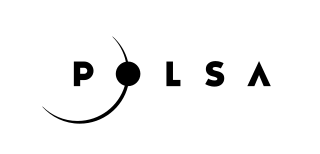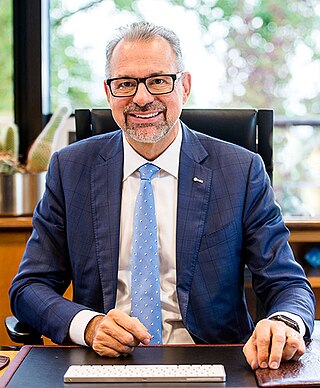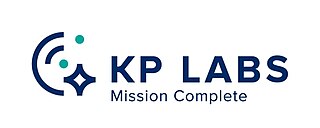
The European Space Agency (ESA) is a 22-member intergovernmental body devoted to space exploration. With its headquarters in Paris and a staff of around 2,547 people globally as of 2023, the ESA was founded in 1975. Its 2024 annual budget was €7.8 billion.

The Canadian Space Agency is the national space agency of Canada, established in 1990 by the Canadian Space Agency Act.
The European Astronaut Corps is a unit of the European Space Agency (ESA) that selects, trains, and provides astronauts as crew members on U.S. and Russian space missions. The corps has 13 active members, able to serve on the International Space Station (ISS). The European Astronaut Corps is based at the European Astronaut Centre in Cologne, Germany. They can be assigned to various projects both in Europe or elsewhere in the world, at NASA Johnson Space Center or Star City.

Major TimothyNigel Peake is a retired British European Space Agency astronaut, Army Air Corps officer and author.

Samantha Cristoforetti is an Italian European Space Agency (ESA) astronaut, former Italian Air Force pilot and engineer. She is the second of two women sent into space by ESA and the first from Italy. Cristoforetti holds the record for the longest uninterrupted spaceflight by a European astronaut, and she held the record for the longest single space flight by a woman until this was broken by Peggy Whitson in June 2017, and later by Christina Koch. She took command of ISS Expedition 68 on 28 September 2022.

Thomas Gautier Pesquet is a French aerospace engineer, pilot, European Space Agency astronaut, actor, musician, and writer. Pesquet was selected by ESA as a candidate in May 2009, and he successfully completed his basic training in November 2010. From November 2016 to June 2017, Pesquet was part of Expedition 50 and Expedition 51 as a flight engineer. Pesquet returned to space in April 2021 on board the SpaceX Crew Dragon for a second six-month stay on the ISS.

Andreas Enevold "Andy" Mogensen is a Danish engineer and ESA astronaut who is best known for being the first Dane to fly in space as part of the European Space Agency's Iriss program. Mogensen has also been involved in a number of other space-related projects throughout his career, including working as a test engineer for ESTEC and as a member of the European Astronaut Corps. In addition to his work with ESA, he has also worked with NASA and other international space agencies. Mogensen returned to space in August 2023 for his second spaceflight to the ISS onboard SpaceX Crew Dragon as the first non-American to serve as a pilot.

Alexander Gerst is a German European Space Agency astronaut and geophysicist, who was selected in 2009 to take part in space training. He was part of the International Space Station Expedition 40 and 41 from May to November 2014. Gerst returned to space on 6 June 2018, as part of Expedition 56/57. He was the Commander of the International Space Station. He returned to Earth on 20 December 2018. After the end of his second mission and before being surpassed by Luca Parmitano in 2020, he held the record for most time in space of any active ESA astronaut, succeeding Italian astronaut Paolo Nespoli, and German ESA astronaut Thomas Reiter, who formally held the record for the longest time in space for any active or retired ESA astronaut.

Aleš Svoboda is a Czech fighter pilot and astronaut. He holds the rank of major in the Czech Army and serves at the 21st base of the tactical air force in Čáslav. In November 2022, he succeeded in the selection procedure of the European Space Agency and became a member of the reserve team of astronauts, thus he is the first astronaut of the independent Czech Republic.

The Polish Space Agency is the space agency of Poland, administered by the Ministry of Economic Development and Technology. It is a member of the European Space Agency. The agency is focused on developing satellite networks and space technologies in Poland. It was established on 26 September 2014, and its headquarters are located in Gdańsk, Poland.

Matthias Josef Maurer is a German ESA astronaut and Materials scientist, who was selected in 2015 to take part in space training.

Josef Aschbacher is Director General of the European Space Agency (ESA), a position he has held since 1 March 2021. His international career in space combines more than 35 years' of experience at ESA, the European Commission, the Austrian Space Agency, the Asian Institute of Technology and the University of Innsbruck.
Die Astronautin is a private German human spaceflight program with the goal of sending the first German woman into space by 2023 via a short-duration flight to the International Space Station. The program was launched by a German private initiative in March 2016, when it sent out a call for German women to apply for a mission to the ISS. The flight will be mainly funded by donors and voluntary financial aid and so far has not received any funding from the German government.

SpaceX Crew-4 was the Crew Dragon's fourth NASA Commercial Crew operational flight, and its seventh overall crewed orbital flight. The mission launched on 27 April 2022 at 07:52 UTC before docking with the International Space Station (ISS) at 23:37 UTC. It followed shortly after the private Axiom 1 mission to the ISS earlier in the month utilizing SpaceX hardware. Three American (NASA) astronauts and one European (ESA) astronaut were on board the mission.

Axiom Mission 3 was a private spaceflight to the International Space Station. The flight launched on 18 January 2024, and lasted for 21 days, successfully splashing down in the Atlantic Ocean. It was operated by Axiom Space and used a SpaceX Crew Dragon spacecraft. The booster, B1080, had previously flown Axiom-2, among other high-profile missions.

Sophie Adenot is a French engineer, helicopter pilot, and astronaut. A French Air and Space Force helicopter pilot with the rank of lieutenant colonel, Adenot became France's first female helicopter test pilot in 2018. In 2022, she was chosen as a member of the European Astronaut Corps.

Carmen Possnig is an Austrian physician and European Space Agency reserve astronaut. After graduating from the Medical University of Graz in 2014, Possnig was a general practitioner resident in Vienna for a few years before working as a research medical doctor at Concordia Station in Antarctica for more than a year starting in 2017. Since 2020, she has been a doctoral student in space physiology at the University of Innsbruck. She was chosen as a reserve in the European Astronaut Corps in 2022.

Marcus Wandt is a Swedish test pilot and member of the 2022 European Space Agency Astronaut Group. In January 2024, he became the third Swedish astronaut to visit space, after Christer Fuglesang and Jessica Meir.

KP Labs is a Polish Private Space company based in Gliwice that specializes in data processing that was founded in 2016 by students of the Silesian University of Technology who wished to continue to peruse satellite development after graduation. KP Labs is subsidized by the Polish and European governments as part of the Silesian Aviation Cluster program which seeks to turn Silesia into an Aerospace hub. In 2024 KP Labs received the ESA's Innovation Award.






























